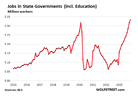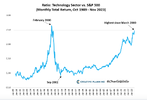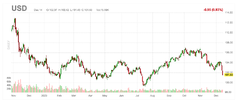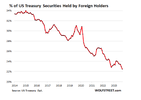- Joined
- 13 February 2006
- Posts
- 5,400
- Reactions
- 12,570
@ducati916, I was reading an article discussing the significant test for the U.S. financial markets, specifically focusing on the appetite for U.S. government debt. The article went on to explain that the U.S. Treasury is set to auction $164 billion worth of bonds, to assess the demand for these securities.
It appears there is growing concern that the increasing levels of U.S. debt might overwhelm the market's capacity to absorb such a massive influx of government securities. I was shocked to read that the issue of $164 billion worth of bonds brings the total sales for the year to a record-breaking $21 trillion.
I'm sure the U.S. government will find buyers for its debt, but if there is a weak demand this could lead to higher interest costs, a larger deficit, and potentially increased financial stress thus causing unforeseen challenges for the U.S. market and beyond.
Duc, I appreciate you have been warning about the dangers of this for a while now but is it something to "worry about" this time around or is it the "same-old-same-old"?
Skate.












no problem at all unless there is a plan to borrow more ( issue more debt )@ducati916, I was reading an article discussing the significant test for the U.S. financial markets, specifically focusing on the appetite for U.S. government debt. The article went on to explain that the U.S. Treasury is set to auction $164 billion worth of bonds, to assess the demand for these securities.
It appears there is growing concern that the increasing levels of U.S. debt might overwhelm the market's capacity to absorb such a massive influx of government securities. I was shocked to read that the issue of $164 billion worth of bonds brings the total sales for the year to a record-breaking $21 trillion.
I'm sure the U.S. government will find buyers for its debt, but if there is a weak demand this could lead to higher interest costs, a larger deficit, and potentially increased financial stress thus causing unforeseen challenges for the U.S. market and beyond.
Duc, I appreciate you have been warning about the dangers of this for a while now but is it something to "worry about" this time around or is it the "same-old-same-old"?
Skate.






















You must be cross-edSo from yesterday's all things VIX:
Old habits die hard: The highest benchmark interest rates in more than two decades haven’t dissuaded income-hungry investors from wading into the derivatives market to generate cash. Citing data from Morningstar Direct, the Financial Times relays that exchange traded funds dedicated to a covered call strategy – i.e., selling options against underlying stock holdings to generate income while curtailing both upside and downside potential within a given portfolio – now boast $59 billion in total assets, compared to just $3 billion in 2020, with net inflows topping $25 billion in the year-to-date. The tally of domestic covered call-focused ETFs has nearly tripled to 60 funds since the plague year.
“The zeitgeist of the retail ETF investor has moved on to income-based products and option-based products,” Dave Mazza, chief strategy officer at Roundhill Investments, observed to the pink paper. Reflecting the spirit of the times: Roundhill itself plans to launch a trio of covered call ETFs after winding down a meme stock-focused fund late last month.
Might that widespread push into options-hedged products be keeping a lid on broader price fluctuations? Alex Kosoglyadov, managing director for equity derivatives at Nomura, argues that the resulting uptick in call option supply has done just that, concluding that “a combination of a dovish macroeconomic backdrop and this systematic [call] selling has really compressed volatility.”
Sure enough, the CBOE Volatility Index (VIX), which measures anticipated 30-day volatility across options tied to the S&P 500, settled at 12.07 on Tuesday for its lowest close since fall 2019 and marked its 19th consecutive session south of 14 today (the gauge’s average reading over the past three decades stands near 20). That preternatural calm marks a striking contrast with last year’s experience, as realized S&P volatility registered at its sixth-highest annual clip going back to the Great Depression, analysts at Bloomberg find.
The shrunken VIX “pointto a degree of over-confidence” in the market, strategists at UBS write, as market expectations of several rate cuts alongside brisk earnings growth in 2024 leaves limited room for error. “Economic data will need to walk a fine line in the coming months to sustain the recent rally. . . equity markets are already pricing in plenty of good news. As a result, we expect a return to more normal levels of volatility.”
Options sellers, please copy.
View attachment 167254View attachment 167253View attachment 167252View attachment 167251
View attachment 167258View attachment 167257View attachment 167256View attachment 167255
View attachment 167259
There is a huge disconnect between fiscal reality and markets currently.
The key to it all is the USD. While the USD remains weak and gets weaker, Bond market turmoil will be contained. If the USD starts to strengthen, there will be issues.
Of course a weak USD drives inflationary pressures. The #1 risk:
View attachment 167260
Oil is down on recessionary fears. OPEC+ remains committed to cuts in supply. The Green nonsense is nowhere near where it would need to be. A 7-handle is not 'cheap'. It is cheaper than a 9 or 10-handle. A weaker USD makes a 7-handle less attractive than it was. But of course oil is very likely to move back higher. Much.
*Not sure why everything has a line through it.
jog on
duc
i have seen mention of increased trade in ' zero day\ ( to expiry ) optionsSo from yesterday's all things VIX:
Old habits die hard: The highest benchmark interest rates in more than two decades haven’t dissuaded income-hungry investors from wading into the derivatives market to generate cash. Citing data from Morningstar Direct, the Financial Times relays that exchange traded funds dedicated to a covered call strategy – i.e., selling options against underlying stock holdings to generate income while curtailing both upside and downside potential within a given portfolio – now boast $59 billion in total assets, compared to just $3 billion in 2020, with net inflows topping $25 billion in the year-to-date. The tally of domestic covered call-focused ETFs has nearly tripled to 60 funds since the plague year.
“The zeitgeist of the retail ETF investor has moved on to income-based products and option-based products,” Dave Mazza, chief strategy officer at Roundhill Investments, observed to the pink paper. Reflecting the spirit of the times: Roundhill itself plans to launch a trio of covered call ETFs after winding down a meme stock-focused fund late last month.
Might that widespread push into options-hedged products be keeping a lid on broader price fluctuations? Alex Kosoglyadov, managing director for equity derivatives at Nomura, argues that the resulting uptick in call option supply has done just that, concluding that “a combination of a dovish macroeconomic backdrop and this systematic [call] selling has really compressed volatility.”
Sure enough, the CBOE Volatility Index (VIX), which measures anticipated 30-day volatility across options tied to the S&P 500, settled at 12.07 on Tuesday for its lowest close since fall 2019 and marked its 19th consecutive session south of 14 today (the gauge’s average reading over the past three decades stands near 20). That preternatural calm marks a striking contrast with last year’s experience, as realized S&P volatility registered at its sixth-highest annual clip going back to the Great Depression, analysts at Bloomberg find.
The shrunken VIX “pointto a degree of over-confidence” in the market, strategists at UBS write, as market expectations of several rate cuts alongside brisk earnings growth in 2024 leaves limited room for error. “Economic data will need to walk a fine line in the coming months to sustain the recent rally. . . equity markets are already pricing in plenty of good news. As a result, we expect a return to more normal levels of volatility.”
Options sellers, please copy.
View attachment 167254View attachment 167253View attachment 167252View attachment 167251
View attachment 167258View attachment 167257View attachment 167256View attachment 167255
View attachment 167259
There is a huge disconnect between fiscal reality and markets currently.
The key to it all is the USD. While the USD remains weak and gets weaker, Bond market turmoil will be contained. If the USD starts to strengthen, there will be issues.
Of course a weak USD drives inflationary pressures. The #1 risk:
View attachment 167260
Oil is down on recessionary fears. OPEC+ remains committed to cuts in supply. The Green nonsense is nowhere near where it would need to be. A 7-handle is not 'cheap'. It is cheaper than a 9 or 10-handle. A weaker USD makes a 7-handle less attractive than it was. But of course oil is very likely to move back higher. Much.
*Not sure why everything has a line through it.
jog on
duc
i have seen mention of increased trade in ' zero day\ ( to expiry ) options
which it seems evades VIX calculations , is the VIX still a relevant indicator .. just asking , because it is very low all things considered it implies everything is going to plan in the global economy ( just like inflation has been beaten )
to me , something seems to be distorting the VIX , even allowing for punters to 'climb the wall of worry 'Mr divs,
These are index covered call strategies. QYLD is an example. The selling of Calls is distorting the VIX.
Is it as useful? No.
It is more dangerous. It now gives a false sense of security as evidenced by the quote from yesterday.
jog on
duc
Very funny but you had to read the whole post to appreciate this comment. I'm still chuckling.*Not sure why everything has a line through it.













G'day duc
still learning
So the recession hits and the fed drops interest rates... is this kicking the can further down the road?
Money contraction
When is judgement day?
The gold response?
The commodities response if commodities cant get above their Bloomberg commodity index 200 MDA?
Is the answer a pineapple...a good rest or a bex?
Cheers in advance




































Hello and welcome to Aussie Stock Forums!
To gain full access you must register. Registration is free and takes only a few seconds to complete.
Already a member? Log in here.